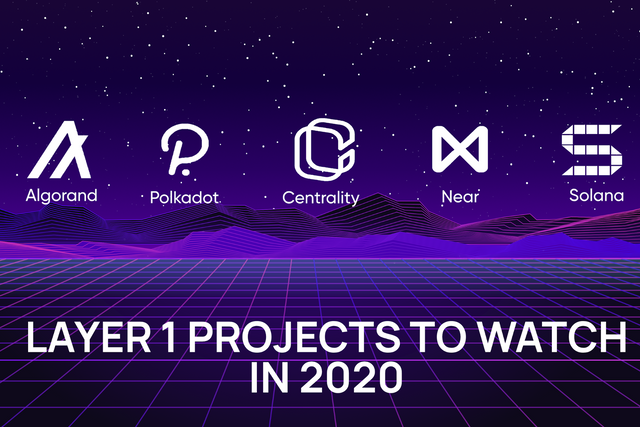Five Layer 1 Projects to watch in 2020

Among all Layer 1 blockchain projects, Ethereum is still king, regardless of its scalability limitations. In order to make their smart contract platform future-proof, Ethereum 2.0 will be rolled out in the upcoming year, but this project is already riddled with problems. Besides having to run a separate blockchain than “legacy” Ethereum, Ethereum 2.0 will not have the ability for atomic transactions and data retrieval will become more expensive.
Ethereum 2.0 is still a work in progress. While their beacon chain and Proof of Stake capabilities will go live once Phase 0 is rolled out, smart contract execution will not become available until Phase 2 and will take several more years until both Ethereum blockchains are fully merged again. In the meanwhile, other Layer 1 projects will either enter the market, or introduce new features, putting Ethereum 2.0 under heavy competition. Let us take a look at five of the most promising projects.
POLKADOT

Currently, NEAR is taking applications for DApp developers to participate in a closed beta test for their mainnet, which will kick off in Q1 2020. While the NEAR Protocol is an ambitious project on the technological side, it still lacks an ecosystem. As such, NEAR is likely the weakest of the five projects listed in this article at the current time, as their protocol is not more innovative than other state of the art Layer 1 projects that currently are beginning to move into enterprise territory.
Right now, most of the ecosystem building focus is on experimental developers through developer meetups and hackathons. If they manage to attract some enterprise ecosystem members and maybe set up an ecosystem fund in cooperation with VC investors, NEAR could still become one of the top blockchain projects in 2020.
SOLANA

While Proof of Stake is the go-to consensus for most current Layer 1 blockchains, Solana takes a somewhat different approach. For some projects, scalability is more important than Layer 1 features. Solana’s Proof of History technology is a novel approach towards the scalability problem. Rather than building blocks on top of one another using block height as a consensus-based “clock” that maintains the correct order of transactions, Solana validators use a sequential hashing function to each maintain their own clock and timestamp blocks. This circumvents the necessity for validators to wait until blocks are propagated throughout the whole network.
While Solana already has a running test net with smart contract capabilities, an official launch date for the mainnet has not been set yet. An internal scalability test has determined that Solana is capable of processing up to 50,000 transactions per second, with an average block time of 400 ms without any sharding, making Solana a good choice for projects that need a large transaction volume with minimal latency.
So far, most of Solana’s efforts were put into product development. Similarly to NEAR, Solana does not have an active ecosystem. While Solana certainly does have an innovative approach, their high-scalability blockchain will need to attract some big players to be worth its salt. After all, 50,000 transactions per second are of no use when there is nobody who wants to transact. Again, this can be remedied by closing key partnerships and by setting up an ecosystem fund.
CONCLUSION
Besides Solana, which uses a proprietary consensus mechanism based on Practical Byzantine Fault Tolerance, all of these blockchain projects use Proof of Stake as a consensus algorithm. While allowing better scalability, PoS consensus is also more resilient against 51% attacks, providing the necessary security and scalability in order to take the development of blockchain technology to the next step on the way towards mainstream adoption.
In 2020, we will see a plethora of mainnet launches and protocol updates to existing networks. It remains to be seen whether these novel blockchains will gain significant traction, compared to Ethereum. There are however some interesting developments, particularly in the field of user experience that we should keep an eye on.
With rising competition for Layer 1 blockchains, ecosystem building becomes maybe the most important part of running a Layer 1 project. While Polkadot takes the cake here with its enormous ecosystem, Centrality and Algorand are close behind with strong high-value partnerships and VC funds for upcoming DApps. NEAR and Solana are only at the beginning of ecosystem building and the efforts they put into that will decide their fate in 2020.
Posted from my blog with SteemPress : https://cryptohype.tech/five-layer-1-projects-to-watch-in-2020/
Congratulations @crypto.hype, you have received a 30% upvote. I'm the Vietnamese Community bot developed by witness @quochuy and powered by community SP delegations